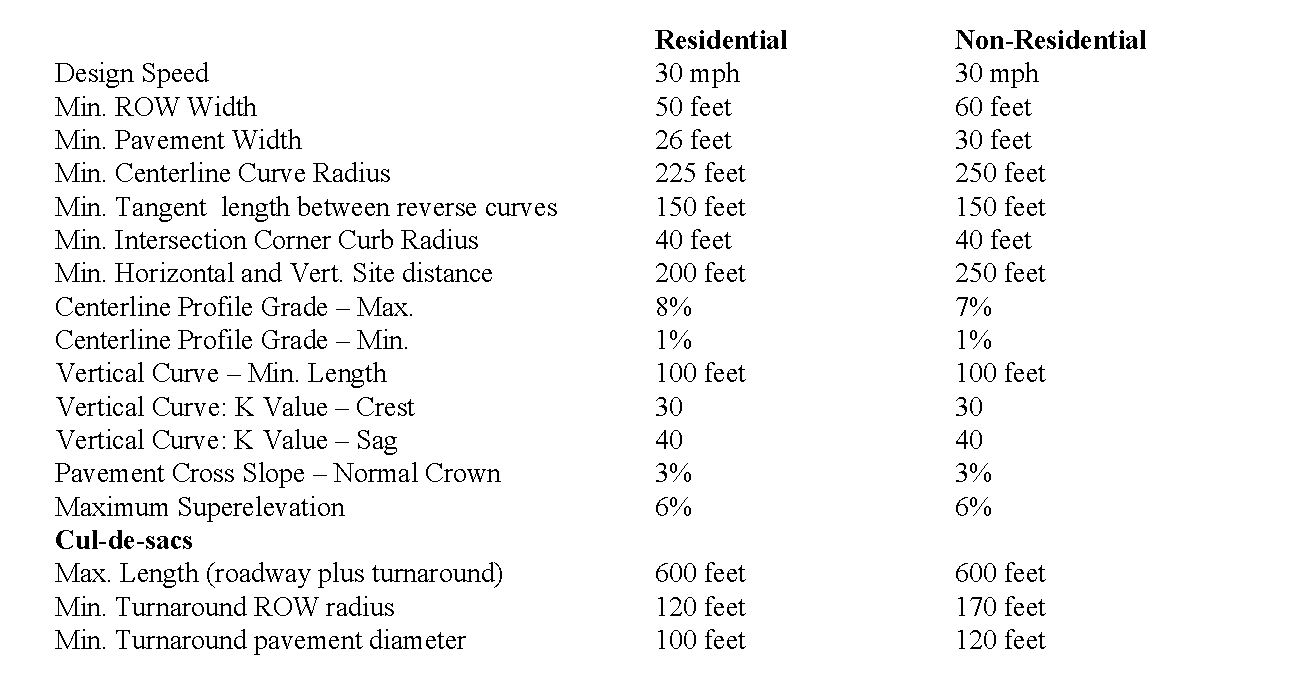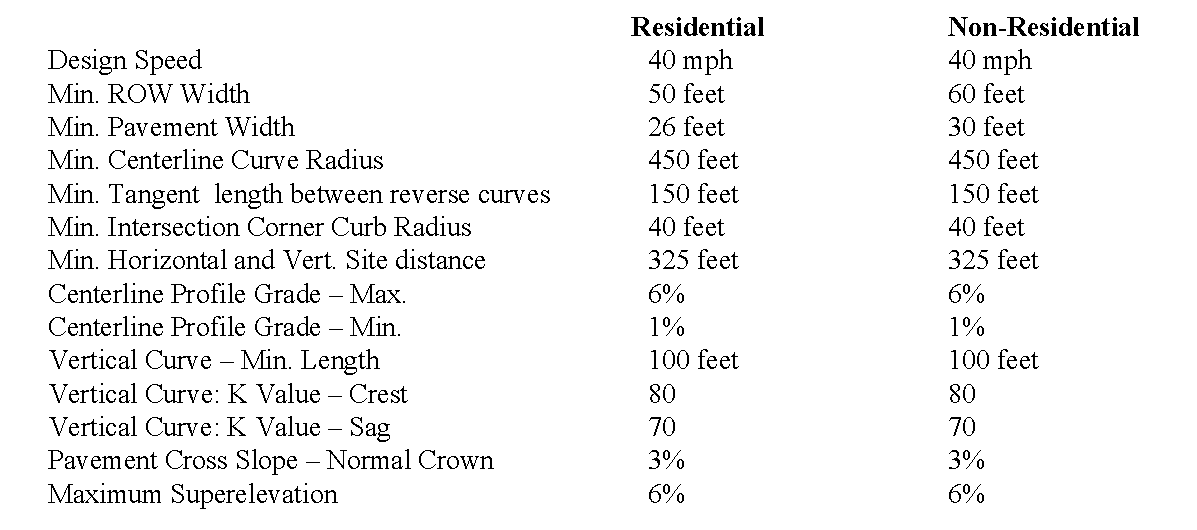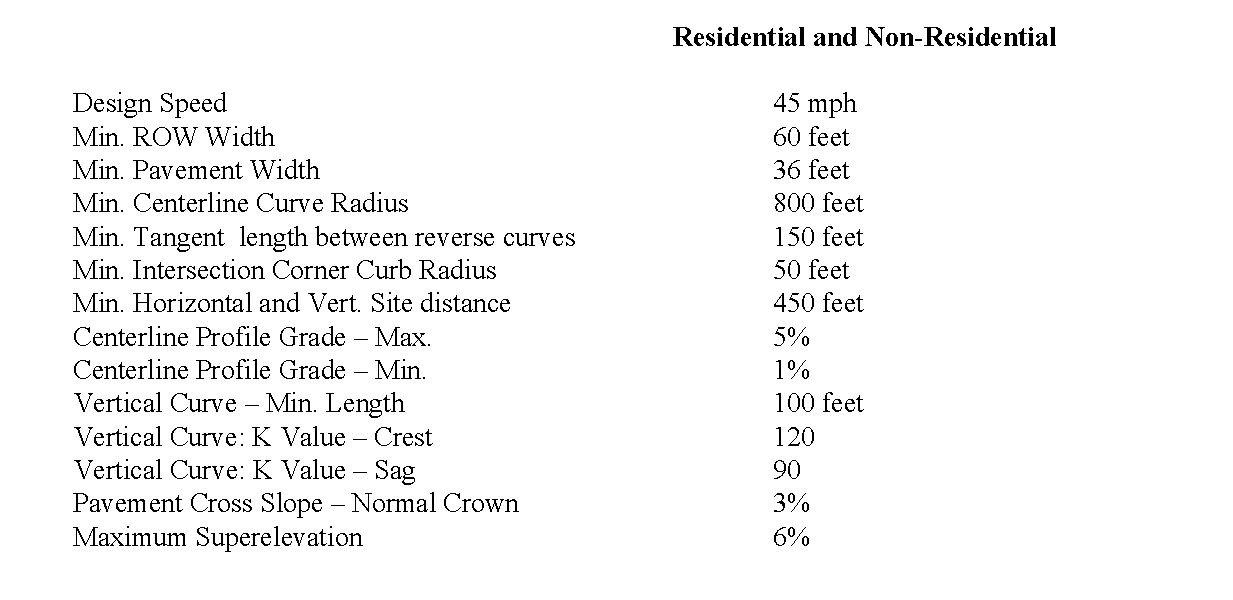In order to provide for streets of suitable location, width and construction to accommodate prospective traffic and afford satisfactory access for police, emergency and medical, fire fighting, snow removal, sanitation and other road maintenance equipment; to coordinate streets so as to compose a convenient system; to avoid undue financial burdens for present and future taxpayers; and to avoid potential natural or technological hazards or nuisances, including the problems associated with uncontrolled storm water run-off, the Board has established the design of subdivisions set forth in this Section.�
In addition to the requirements established in these regulations, all subdivisions shall conform to the provisions of the Town of North Andover Zoning By-law, the regulations of the North Andover Board of Health, the Town of North Andover Water Rules and Regulations, the Town of North Andover Sewer Regulations, the Town of North Andover Zoning By-law and Rules and Town of North Andover's Wetlands Protection Bylaw and its regulations, and all other rules and regulations applicable in the development of land in North Andover.�
6.2.1 Protection of Natural Features:�
In laying out of a subdivision, the Applicant shall comply with these rules and regulations with due regard to all natural features such as large trees, watercourses, scenic or historic elements, aquifers, flood plains, habitats of rare or endangered species, and any state listed plant species as defined by the MA Natural Heritage & Endangered Species Program. These features shall be left undisturbed wherever practical and the Board may waive design requirements in order to protect important natural features.�
New subdivisions shall in all cases be designed so that compatibility with existing neighborhoods is achieved, and the maximum amenities (sidewalks, utilities, guardrails and fences, curbing) within the new development are created.�
New subdivisions shall in all cases be designed to achieve the least amount of earth disturbance (cutting, filling, regrading).�
6.2.2 Unsuitable Land:�
Land which the Board finds to be unsuitable for development due to flooding, improper drainage or adverse drainage, adverse topography, poor soils, bedrock, location of utility easements, or other features which the Board has reason to believe would be detrimental to the health, safety, and general welfare of the present or future inhabitants of the subdivision and/or its surrounding area, shall not be subdivided or developed unless adequate measures are formulated by the Applicant and are approved by the Board to eliminate or minimize any short-term or long-term impacts created by development of the unsuitable land.�
�
6.2.3 Subdivisions Straddling Municipal Boundaries:�
Whenever access to the subdivision is required across land in another Town, the Board will not approve subdivisions where the access to the subdivision is required across land in another Town.�
6.2.4 Self-Imposed Restrictions:�
If, as part of a subdivision application, the Applicant or Owner places voluntary restrictions on any of the land contained in the subdivision which are greater than the requirements of these Regulations or of the Town of North Andover By-law, such restrictions or references thereto shall be indicated and located on the Definitive Plan and shall be recorded in the Essex South District Registry of Deeds or the Land Court.�
6.3.1 Lot Arrangement:�
Lots shall be arranged so there will be no foreseeable difficulties due to topography, soils, Wetland Resource Areas, bedrock, improper drainage, or other conditions, in securing permits to build upon all lots in compliance with the Town of North Andover Zoning By-law, nor in providing practical, feasible driveway access to a building on each such lot.�
6.3.2 Lot Dimensions:�
Lot dimensions shall comply with the minimum standards of the Town of North Andover Zoning By-law. Dimensions of corner lots should be large enough to allow for erection of buildings and fulfilling the minimum front yard setback and lot width from both streets. Depth and width of properties laid out for business or industrial use shall be adequate to provide for the off-street parking and loading facilities required by the Zoning By-law.�
6.3.3 Soil Preservation, Sedimentation and Erosion Control:�
The applicant shall comply with the Rules and Regulations Governing Soil Erosion and Sedimentation Control as provided for in Appendix VI of these rules and regulations.�
Lots shall be laid out to provide positive drainage away from all proposed buildings. Individual lot drainage shall be designed to avoid concentrating stormwater drainage from each lot onto adjacent lots and/or the street.�
6.3.5 Debris and Waste:�
No construction debris, junk, rubbish or other non-biodegradable waste materials shall be buried on any land in the subdivision or left on any lot or on the street right of way, and removal of the same shall be required prior to final release of any covenant or security. Stump dumps are not allowed.�
The specifications for construction, as referenced in Appendices I through VI of these Rules and Regulations, shall be used as a guide for required construction specifications unless otherwise directed. The Board, upon recommendation from the Board's Designee, shall determine if the standards have been met.�
6.5.1 Notification to subdivision inspector:�
No step in the construction of the required improvements shall commence until the Board's Designee has been notified at least forty-eight (48) hours in advance of the beginning of construction phases.�
6.5.2 Inspections:�
Each phase or step in the construction of the required improvements shall be inspected and approved in writing by the Board's Designee. The Board's Designee may require submittals and testing as necessary to assure proper construction. At a minimum, the applicant shall request an inspection at the following stages of construction: �
a) following stakeouts of the limits of clearing and grubbing �
b) following clearing and grubbing, stakeout of the top and bottom of street side slopes and prior to the placement of any fill material �
c) during installation of all utilities and prior to any backfilling of utility excavations �
d) following construction of detention/retention ponds and other stormwater management structures �
e) following fine grading and compaction of roadway pavement subgrade and prior to placement of gravel subbase material �
f) following placement, compaction and grading of the roadway pavement gravel and crushed stone subbase courses �
g) during placement of the bituminous concrete base course(s) �
h) during construction of granite curb and edging �
i) during placement of bituminous concrete top course �
j) following fine grading and compaction of sidewalk and path pavement subgrade �
k) following placement, compaction and grading of the sidewalk and path gravel base course material �
l) during sidewalk pavement construction �
m) following installation of bounds and all other improvements�
The applicant shall not proceed with construction of any of the above stages of development until the Board's Designee has signed off on the previous stage.�
The Board's Designee may require inspection at such other intervals as deemed necessary to assure proper construction of improvements, including but not limited to as-built drawing submittals required under Section 5.14. In addition, the Board's Designee may require periodic inspection reports from the applicant's engineer.�
The applicant shall employ a certified testing laboratory for material testing. As a minimum, the following materials shall be tested for conformance with these specifications: �
a) Gravel subbase �
b) Crushed stone subbase �
c) Processed gravel backfill �
d) All bituminous concrete mixes �
e) Cement concrete Manufacturer's certification shall be furnished for �
a) All types of pipe and pipe system appurtenances �
b) Precast drainage; sewer and retention/detention pond outlet structures�
6.6.1 Clearing and Grubbing:�
The area within the proposed street rights of way shall be cleared and grubbed except for those trees which are intended to be preserved as street trees and to be retained in side slope areas.�
6.6.2 Earth Excavation:�
�
All excavation shall conform to the lines and grades shown on the approved Definitive Plan(s). Where organic soils, ledge or clay is encountered within the right of way, it shall be removed entirely and, where necessary, replaced with sand and gravel. Where water is encountered, or is expected to be encountered, within four feet (4') of the finished grade of the street, subsurface drainage, of a design acceptable to the Board, upon recommendation from the Board's Designee, shall be installed. Proposed roadway side slopes higher than 15' shall contain horizontal benches with drainage swales to ensure side slope soil stability.�
6.6.3 Ledge Excavation:�
Boulders or ledge shall be removed to a depth of at least twenty-four inches (24") below finished grade wherever it exists within the road or sidewalk pavement area.�
6.6.4 Retaining Walls:�
If street and/or side slope grades require more than two feet (2') of cut or fill, the Board may require retaining walls along abutting property lines unless a suitable alternative is approved by the Board.�
6.7.1 Frontage:�
No subdivision shall be approved unless the land to be subdivided shall have frontage on an existing or proposed public street or, if the area to be subdivided is to use a private way to access the public street, the private way shall be improved or constructed by the applicant to meet the minimum design and construction requirements of these Regulations.�
6.7.2 Improving Existing Streets:�
If a subdivision borders an existing but inadequately constructed public or private street, the applicant may be required to improve the street bordering the subdivision tract or provide the land necessary for future improvements for that portion bordering the subdivision. Land used for or reserved for future street improvements may not be counted in satisfying the setback and area requirements of the Town of North Andover Zoning By-law. If the projected traffic generation from the proposed development, as determined in the traffic impact analysis required in article 5.4.4.6, will have adverse impacts on traffic conditions on existing public streets, and their intersections, the applicant shall construct and pay for the improvements required to mitigate or minimize the impacts.�
6.7.3 Topography and Location:�
Streets shall be designed and located to conform as closely as possible to the original topography of the site. There shall be a minimum amount of cut and fill in the design and construction of the streets. The overriding concern is public safety, therefore the overall topography of the site shall be taken into consideration, resulting in an avoidance of steep grades and curves.�
6.7.4 Street Names:�
Proposed street names shall be included on the plans and shall be sufficiently different in sound and in spelling from other street names in the Town so as not to cause confusion. A street which is planned as a continuation of an existing street shall bear the same name. The proposed street name shall be included in the application submitted to the Board. E 911 shall give final approval of all street names.�
6.7.5 Street Numbers:�
Street numbers shall be assigned by the DPW and shall be included in the application submitted to the Board.�
6.8.1 Table IA Minimum Design Standards for LOCAL Streets (Design Speed: 30 miles per hour)�

6.8.2 Table IB Minimum Design Standards for COLLECTOR Streets (Design Speed: 40 miles p.h)�

6.8.3 Table IC Minimum Design Standards for ARTERIAL Streets (Design Speed: 45 miles p.h)�

6.8.4 Street Geometry:�
Street geometry (i.e., horizontal and vertical alignment) should be selected to achieve both safe vehicular movement and adequate sight distances for associated design speeds. The design engineer shall demonstrate conformance to this objective by providing tables of calculations which indicate the resultant sight distances.�
6.8.5 Excess Right-of-Way:�
Right of way widths in excess of the standards designated in Tables IA, IB, and IC may be required whenever, due to anticipated future traffic/loading conditions, additional width is necessary to provide improved alignment.�
6.8.6 Cul-de-sac - Temporary:�
The subdivision design shall provide for continuation of streets between adjacent properties when such continuation promotes the convenient movement of traffic, effective fire protection and emergency vehicle access, efficient snow removal service and efficient provision of utilities.�
If the adjacent property is undeveloped and a street must be dead-ended temporarily, the right-of-way shall extend to the property line.�
6.8.7 Cul-de-sac- Permanent:�
If a street will not extend beyond the subdivision boundaries and its continuation is not required for access to an adjoining property, the terminus shall not be nearer the subdivision boundary than fifty feet (50'). A permanent dead-end street shall be provided with a cul-de-sac turnaround in accordance with Section 6.8.1, Table IA.�
6.8.8 Reserve Strips:�
Reserve strips prohibiting access to streets or adjoining property shall not be permitted except where, in the opinion of the Board, such strips shall be in the public interest.�
6.8.9 Intersections:�
Streets shall be laid out so as to intersect as nearly as possible at right angles, and in no case at less than a 75 degree angle. New intersections at one side of an existing street shall align directly with any existing intersection at the opposite side of the street whenever feasible. Street intersection jogs with centerline offsets of less than one hundred and fifty feet (150') shall not be permitted.�
Street intersections shall be designed with a flat grade (not greater than 3%) for a distance of at least one hundred (100') feet as the street approaches each side, as applicable, of any intersecting street.�
The minimum sight distances (in both directions) at all intersections of streets shall be the decision sight distance listed in Section 7 of the MHD Highway Design Manual.�